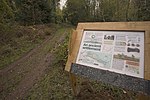St Nicholas' Church, Brockley

St Nicholas' Church in Brockley, Somerset, England dates from the 12th century, and is recorded in the National Heritage List for England as a designated Grade II* listed building. The church is a redundant church in the care of the Churches Conservation Trust. It was vested in the Trust on 1 April 1989.The Norman church has a pinnacled tower which was added in the 15th century, and the whole church was extensively renovated in the 1820s by the Pigott family,. The font is Norman and there is a stone pulpit dating from around 1480. Inside the church is a Royal Coat of Arms dating from 1842 by William Edkins.The building is used as a local arts venue with service generally being held in the church twice a year, however special permission can be obtained for weddings.
Excerpt from the Wikipedia article St Nicholas' Church, Brockley (License: CC BY-SA 3.0, Authors, Images).St Nicholas' Church, Brockley
St. Nicholas Way,
Geographical coordinates (GPS) Address External links Nearby Places Show on map
Geographical coordinates (GPS)
| Latitude | Longitude |
|---|---|
| N 51.399444444444 ° | E -2.7691666666667 ° |
Address
St. Nicholas Church
St. Nicholas Way
BS48 3AU , Brockley
England, United Kingdom
Open on Google Maps






